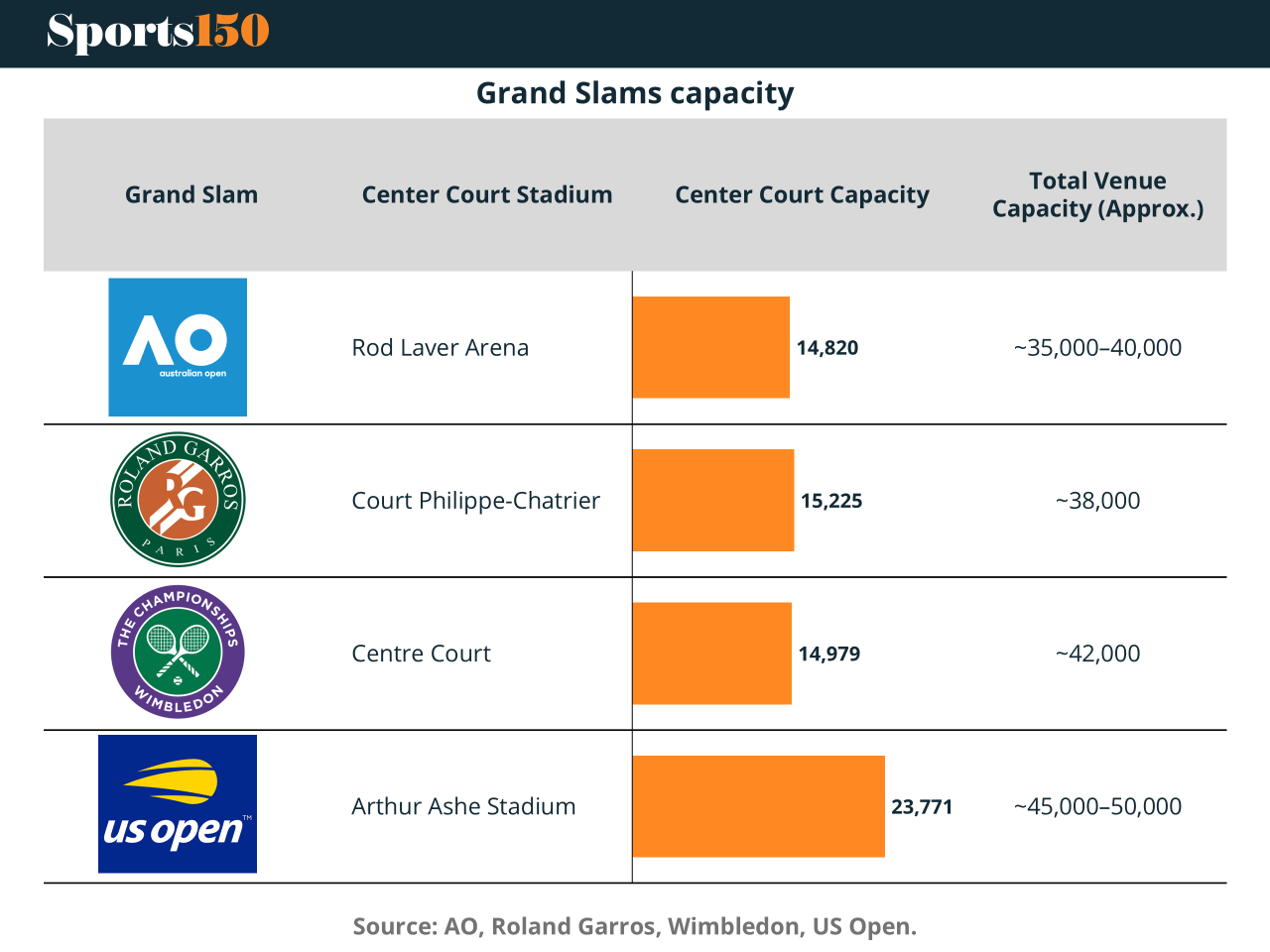- Sports 150
- Posts
- Facilities Grand Slams: The Billion-Dollar Stadium Race Behind Tennis’ Biggest Events
Facilities Grand Slams: The Billion-Dollar Stadium Race Behind Tennis’ Biggest Events
How infrastructure investment is reshaping the economics—and prestige—of tennis’ four crown jewels
In the ultra-competitive world of global sports, tennis’ Grand Slam venues are in a quiet arms race. The numbers are staggering: Melbourne Park has undergone a AUD $972 million redevelopment; Roland Garros spent €380 million (~USD $415 million) to modernize its grounds; and Wimbledon is midway through a high-profile expansion fueled by debenture sales reaching £116,000 per seat. Meanwhile, the US Open’s Arthur Ashe Stadium remains the largest tennis venue globally and has seen over $500 million in cumulative upgrades since its 1997 debut.
The Strategy Behind the Spend
These are not just vanity projects. For host cities and governing bodies, upgraded tennis infrastructure is a calculated economic investment. The 2024 Australian Open alone generated AUD $533.2 million for the state of Victoria, with over $3.14 billion in cumulative benefits over the past decade. The venue's transformation—including the construction of the new Kia Arena and Centrepiece events space—was not just about tennis; it was a platform for year-round events, conferences, and sports tourism.
Similarly, Wimbledon’s massive expansion—including 39 new grass courts and an 8,000-seat show court—is designed to defend its relevance as the sport becomes increasingly globalized. The All England Club is using long-dated debentures (effectively prepaid ticket sales) to finance the build-out, creating a self-funding upgrade cycle that preserves elite exclusivity while expanding capacity.
In New York, the USTA’s choice to issue $150 million in municipal bonds to fund Arthur Ashe’s retractable roof was a bet on weather-proofing broadcast rights and fan experience. The venue’s 23,771 seats generate the most ticketing revenue in tennis, and the USTA has continued to reinvest aggressively to maintain its lead.
Capacity Arms Race: Bigger Crowds, Bigger Returns
Investment in Grand Slam venues isn’t just about amenities—it’s also a capacity play. Arthur Ashe Stadium leads the field with 23,771 seats, anchoring a complex that draws up to 50,000 attendees per day. By contrast, Rod Laver Arena holds 14,820, while Wimbledon’s Centre Court seats 14,979 and Roland Garros’ Philippe-Chatrier clocks in slightly higher at 15,225. Overall venue capacities range from ~35,000 to 50,000, with Wimbledon and the US Open outpacing the others thanks to multi-court layouts and auxiliary stadiums.
Larger venues mean more revenue—through tickets, concessions, hospitality suites, and merchandise. But they also create logistical complexity: crowd control, security, and broadcast infrastructure all scale with size.

Why It Matters for Investors
The evolution of these facilities is not just about sport—it’s a template for asset monetization. These venues generate year-round returns through multi-use capabilities, hospitality revenues, and naming rights, offering a blueprint for PE firms looking at infrastructure or sports investments. More importantly, the model—public-private funding, long-term yield via events and real estate, and integration with tourism strategies—mirrors broader trends in entertainment real assets.
As tennis globalizes and fans demand more immersive, consistent experiences, expect more stadiums to follow suit—not just in tennis, but across the sports investment landscape.
Sources & References
Architect Magazine. (2016). The Arthur Ashe Stadium. https://www.architectmagazine.com/project-gallery/arthur-ashe-stadium
Australian Open. (2024). Australian Open confirmed as biggest economic generator in Aussie sport. https://ausopen.com/articles/news/australian-open-confirmed-biggest-economic-generator-aussie-sport
Financial Times. (2025). Price of Wimbledon tennis debenture seats jumps 59% to £73,000. https://www.ft.com/content/b55b0888-c108-49ff-b225-992c04c97f7d
Finews. (2024). Investors Have Reason to Celebrate at the US Open. https://www.finews.com/news/english-news/64076-us-open-new-york-arthur-ashe-stadium-investment-infrastrukturen-bny-invstments-martin-rees-jeffrey-burger-novak-djokovic-2
Graphicviews. (2025). Transformation of Roland Garros Venue. https://www.graphicnews.com/en/pages/37398/tennis-roland-garros-renovation
The Athletic. (2025). Grand Slam prize money is enormous. The economics of tennis tournaments is complicated. https://www.nytimes.com/athletic/6043299/2025/01/09/tennis-prize-money-grand-slams-revenue/